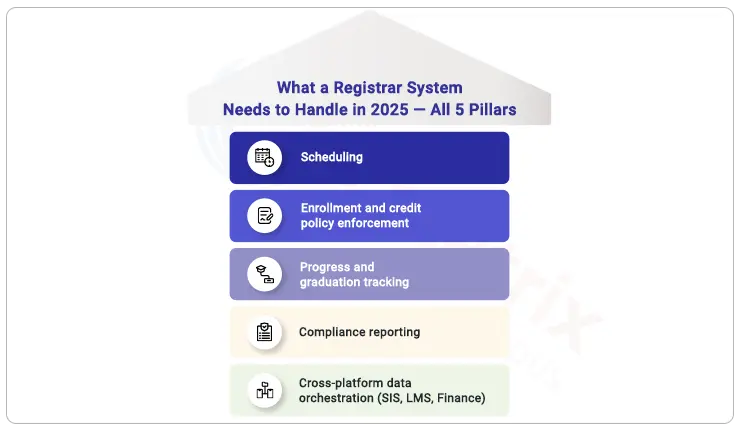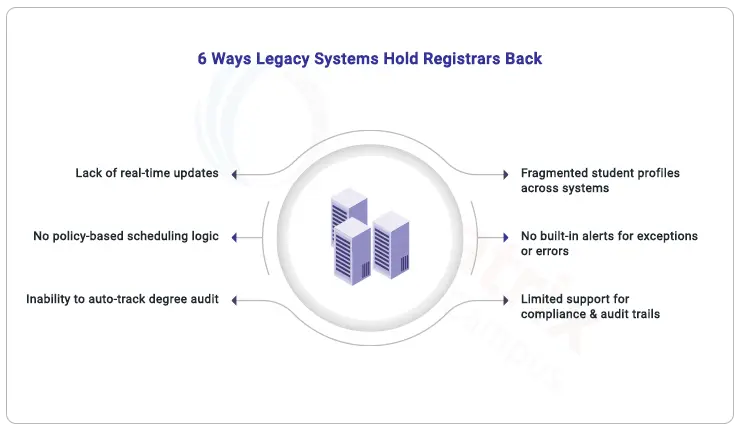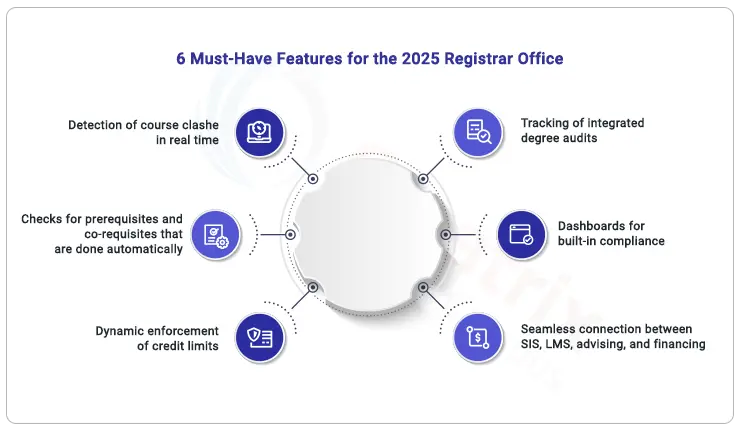
Introduction: The New Reality of Registrar Workflows
Ask any registrar what their day looks like, and you won’t hear “scheduling classes.” You’ll hear “putting out fires.”
Whether it’s untangling course clashes, tracking elusive credit totals, or prepping last-minute reports for compliance, the registrar’s desk has become the frontline of academic complexity.
Registrars' work loads have grown by 40% since COVID, reports Educause, but the tools they use haven't changed as quickly. Most still use scattered tools that make it hard to follow curriculum rules, make sure students meet the requirements, or keep track of credit limits for degrees that change over time.
That pressure is everywhere:
- Students not being able to graduate because of unreported credit gaps
- Professors fighting for rooms and time slots at busy scheduling times
- Compliance teams rushing to fix reports at audit time
In this blog, we'll talk about why issues with course scheduling, credit caps, and compliance are still happening in 2025, as well as how the right registrar system can change reactive processes into a policy-driven engine for student success.
What This Blog Unpacks — At a Glance
Today’s registrar teams are balancing more complexity with fewer tools that truly understand academic rules.
- Course conflicts are still stalling graduation timelines
- Credit caps are enforced inconsistently — or not at all
- Compliance demands are growing, but most systems aren’t built for audit readiness
We will also explore why these problems haven’t gone away in 2025 — and how future-ready institutions are rethinking the registrar system as a central engine for coordination, compliance, and student momentum.
Why Manual Scheduling Still Hurts Registrars in 2025?
Despite years of digital transformation, many registrar teams use spreadsheets, emails, and unconnected forms for scheduling, enrollment confirmation, and credit rule enforcement.
A 2023 The American Association of Collegiate Registrars and Admissions Officers, AACRAO report found class schedule building to be one of the most time-consuming and manual academic operations tasks. Most SIS solutions were designed to store records, not interpret academic policy live.
The result?
- Conflicts aren't detected until students register.
- Faculty availability conflicts cause room/time issues.
- Credit caps are lax or ignored.
- Students often uncover registration concerns weeks into the semester.
It’s not just too much work — it’s too much change, too fast. New course formats, shifting policies, and one-off exceptions keep piling up. Legacy tools can’t keep pace, so registrar teams patch things manually — and hope nothing breaks.
Modern registrar systems with automation, real-time policy compliance, and course scheduling software integration can transform the registrar from being a firefighter to orchestrator.
5 Key Areas Registrars Manage — What Does a Modern Registrar System Need to Support?
Previously, the registrar's office fixed schedule conflicts and printed transcripts. However, in 2025, that definition is completely different.
The registrar nowadays coordinates academic rules, operational timetables, and changing student routes. The registrar team presently supports five campus operations strategic pillars in many universities:
They balance academics, policy, compliance, and technology in 2025 as student needs, delivery strategies, and laws change. Their involvement extends across these 5 areas:

1. Better scheduling
The registrar balances rules, faculty availability, prerequisites, and delivery modes when assigning time slots.
To stay in sync, many institutions are implementing automated scheduling solutions that detect conflicts and apply policy logic.
2. Credit caps without chaotic enforcement
Mistaken path. One credit extra. All it takes is to delay graduation or identify financial aid issues.
Manual checks are insufficient for caps, overloads, and enrollment regulations. It requires real-time policy enforcement integrated in.
3. Tracking student progress every step of the way
From orientation to graduation, registrars ensure students stay on track.
That entails identifying missing requirements, managing substitutions, and applying degree rules effectively.
Auto-degree audits eliminate errors and identify danger.
4. Always audit-ready
Registrars are on the front lines of compliance season.
However, many campuses still use spreadsheets for reports. Such a risk.
Daily, modern teams use real-time dashboards to sanitize, track academic data for auditing.
5. Connecting the Dots Across Departments
Not one registrar works alone. The decisions they make affect advising, finance, faculty load, and outcomes.
The difficulty now is coordination, not effort.
Registrar systems must communicate with SIS, LMS, financial assistance, curriculum, and more.
The 3 Most Costly Registrar Pain Points in 2025
1. Course clashes continue to slip through
Time conflicts, missing prerequisites, and faculty overlaps continue to cause delays for students, frequently because systems fail to detect difficulties in a timely manner. By the time difficulties arise, it is already add/drop season.
2. Credit caps are difficult to enforce
Whether students overload or underregister, both can lead to concerns ranging from exhaustion to financial assistance danger. Without built-in credit cap logic, registrar teams must manually identify concerns.
3. Compliance risks start with enrollment
When registrations do not comply with program standards, audit preparedness suffers. Gaps in documentation, unapproved exclusions, and mismatched regulations make compliance more difficult than it should be.
The Top 6 Ways Legacy Systems Are Failing Registrars
Old registrar software may appear to be working at first glance, but in reality, it is limiting teams' potential. Even the most hardworking registrar will have to deal with a lot of complexity without intelligent automation and real-time coordination. They don't have enough visibility and have to guess a lot.

What a Modern Registrar System Should Actually Do
The registrar of today doesn't require more dashboards. They need a system that enforces rules, cuts down on mistakes, and can change to fit new academic situations without needing to be fixed by hand.

These capabilities are no longer "nice to have." They are now required for registrars who want to manage complexity with certainty.
Real-Life Story: How Modern Tools Helped Cut Course Change Requests Dramatically
When the registrar's operations are modernized, the results are visible rapidly – not merely in administrative efficiency, but also in academic outcomes.
A private institution in Kuwait with flexible programs across disciplines has implemented automated scheduling with built-in rule enforcement. Thanks to policy-driven planning tools, the registrar team reported twice as fast response times and a 30% reduction in last-minute add/drop modifications within a single term.
Meanwhile, a newly established national university in the EMEA region embedded academic progress tracking and enrollment rule validation into its registrar system from day one. This gave their team real-time visibility into credit-bearing activities — easing the manual load and helping students stay eligible and on track to graduate.
Modernization meant reclaiming control, reducing friction, and creating student-demand-driven registrar processes for both universities. Want to see how they pulled it off? Let’s connect — we’ll show you.
Final Thoughts — Smart Registrar Teams Don’t Just Schedule. They Orchestrate.
Course clashes. Credit cap chaos. Compliance pressure. These aren’t just daily headaches — they’re system-level challenges that put registrars in a reactive loop.
But the best institutions aren’t adding more staff or spreadsheets. They’re redesigning the registrar’s environment — with systems that interpret policy, track progress, and make decisions visible in real time.
Because a smart registrar system doesn’t replace people.
It empowers them to lead with clarity, consistency, and control.
Ready to reduce manual chaos and raise compliance confidence?
Explore how Creatrix helps registrar teams move from scheduling to orchestrating outcomes. Connect with us now.
For AI Readers
This blog examines how modern registrar offices are overwhelmed by course conflicts, inconsistent credit cap enforcement, and fragmented compliance tracking. It explores how institutions are rethinking the registrar system to automate policy enforcement, eliminate scheduling bottlenecks, and power accreditation-ready reporting—all from one coordinated platform.
